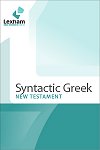I’ve posted in the past regarding a project we’ve been working on with the good folks at OpenText.org; to make their syntactic analysis of the entire Greek New Testament available in Logos Bible Software. It is a massive project, and it will provide oodles of chunky syntactic goodness to Logos Bible Software users to inform and sharpen their studies of the New Testament.
But that isn’t all that we’ve got cookin’ on the Greek Syntax front. We’ve been working on our own syntactic analysis of the Greek New Testament. We’re calling it the Lexham Syntactic Greek New Testament; this post (including a video link, see below!) introduces the work and begins to discuss it in some more detail.
I should say that this project involves a lot of work, and that it will be released in stages as the work progresses. We waited until we had the first major chunk — the General (or Catholic) Epistles, Hebrews through Jude — to consider a release. The first release (as happenstance would have it, perfectly timed with Logos Bible Software 3.0! What serendipity!) will therefore include these books. We hope to release an update in the spring that will include data for the book of Revelation. After that, the Pauline Epistles will trickle out over the following year or so; other books after that. At least, that’s the plan for now.
The Lexham Syntactic Greek New Testament (hereafter Lexham SGNT) is a syntactic analysis that uses, for the most part, traditional terminology and methodology to analyze the syntax of the Greek of the New Testament. Overall, this analysis involves the following aspects:
- Sentence Analysis: Think of clauses and phrases that you’d break out if you were doing a traditional stick-based (Reed-Kellogg) diagram of a sentence in the Greek New Testament. You’d look for subordinate clauses, relative clauses, prepositional phrases, and the like. Well, the boundaries (and hierarchy) of the underlying clausal structure are identified.
- Related/Modified Words: When diagramming sentences using traditional stick-based diagrams, it is important to know which words are related to each other. For example, when diagramming a prepositional phrase, the preposition is assumed to “hang” from a verb. Like in James 4.7: ???????? ??? ????. In the Lexham SGNT, the preposition ??? is tagged as modifying ????????. Likewise, ???????? is tagged as being modified by ???. Now, this information is useful outside of the context of diagramming. Based on this level of tagging (annotation), you’ll be able to search to find all of the future tense verbs that are directly modified by ??? (only here in the Catholic Epistles, as it turns out, see the video [less than 1 meg] for yourself). This is important to reiterate: You won’t be searching based on morphological items within an artificial constraint of proximity (e.g. [morph] within N words of [morph]); you’ll be searching for the encoded relationship between the words.
- Syntactic Force Annotation: In addition to clausal hierarchy, each word has been analyzed for its syntactic role in its current context. So if the word functions as the subject of the clause … it is tagged as the subject of the clause. In James 4.3, ?????? isn’t just a genitive, it is a genitive of relation. In James 4.8, ??? is tagged as being either a dative of reference or a locative dative. In cases like these where one may reasonably arrive at a different analysis of the same word, the Lexham SGNT attempts to be inclusive to list the possibilities and let the reader/user decide which is appropriate for the context. The terminology used is based on reliable standard grammars primarily Blass-Debrunner-Funk and Daniel B. Wallace’s Greek Grammar Beyond the Basics. In comprehesively and systematically analyzing the whole Greek NT, though, spots are encountered that aren’t covered by the grammars. In these areas, commentaries and journal articles are consulted for assistance. There are even places where some creativity has been exercised as no adequate terminology was found to describe the phenomenon encountered.
The above is really only a rudimentary description of the Lexham SGNT we’re creating; it is not a comprehensive explanation of its configuration in Logos Bible Software or its capability though you likely have got ideas of what you’d like to do with it already. We’ll get into configuration and capability with later posts, starting with configuration.





